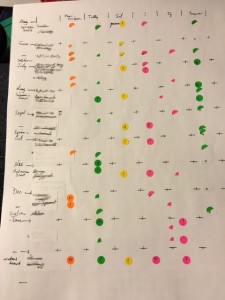Who is to blame? This is an interesting question, because it is asking more than “who caused this?” – it is asking “who is at fault for this?”
It is interesting from a writing standpoint because blame very often has a load of anger attached, and the finger of blame is not always reasonable in selecting a target. In other words, it is a prime way of adding conflict to a story.
Have something unfortunate happen. Have one character blame another for it. Good – conflict!
Have one character blame another for it unfairly. Better – more conflict!
Not only can it add conflict, it can also expose information about the characters involved: how the culprit is determined, how the wronged party behaves towards the culprit, and how the culprit responds – all great stuff!
This came to mind because of an incident last night.
Rob and I had a dinner gathering for the first time in our new/old house. We have had a few people swing by, but this was the first time we were trying to feed multiple people at the same time, and in style. All rather stressful to start with, since we don’t have a lot of practice entertaining.
So I was in the kitchen, trying to get the last few things ready. Rob was showing most of the guests around outside, and I was chatting with one guest while I worked.
Through the kitchen window I saw a dog streak by. Rather worrisome, because one of my cats was outside, and we don’t usually get dogs.
I commented on it, and the guest said “Oh, that’s Tim’s dog.”
One of the guests had brought a dog? News to me.
The crew stayed out an unexpectedly long time, and when at length they came in my sneaking fears were realized: the dog had treed my cat.
Well and thoroughly.
Forty feet up a Douglas Fir.
I was not happy.
I didn’t do anything regrettable, but I left Rob to keep everyone entertained while I went out to see whether I could lure Avanti down.
Already, the finger of blame was looking for a target, never mind that I wasn’t about to give voice to it.
The obvious person to blame was the guest in question, the “gentleman friend” of one of our friends. He seemed like a prime candidate, because it was his dog, and he might or might not be around for the long term.
Note that it is very convenient to blame someone if there isn’t a major cost to blaming them.
Avanti came down by a couple branches in response to my calling, but didn’t make it any further. Rob brought the ladder and helped me put it up in the fading light, but it was a good ten feet short. I reluctantly went back in, since there was nothing I could constructively do.
As it turned out, Avanti made it down just fine all on her own, after I “abandoned” her. This story has a happy ending, so there is no need for me to pin blame on anyone. Note how the lack of consequence lightens the load of blame to almost nothing.
But what if she had fallen? Been seriously injured? Killed?
Then the finger of blame would anxiously seek out a victim.
It is interesting to look at this as an example, and consider different interpretations – and who might pick one or another.
Here are the prime candidates:
- The dog. He treed the cat. But that’s pretty much what dogs do, so most people wouldn’t be inclined to lay blame there.
- Avanti. She ran. The dog followed. But running from dogs is pretty much what cats do, so most people wouldn’t be inclined to lay blame there.
- The guest who had brought the dog. It was his dog, so he was clearly responsible.
- Rob. Rob had given the guest permission to let the dog out. He did not know Avanti was out, but he didn’t double-check. On the other hand, the guest assured him that the dog did not chase things when he was around. Which turned out not to be true. So maybe the guest was to blame, after all.
- Me me me. I hadn’t seen that there was a dog, because I was busy getting final touches together, but if I had actually looked out properly I would have seen it in time to forestall a problem.
This is where it gets interesting, because there isn’t necessarily a right answer. There are more and less rational answers, but there is some basis for any of these interpretations.
And this is where a writer can have some fun, depending on the desired level of conflict and/or character exposure desired.
Rational:
Rob is to blame. He gave permission for the guest to let the dog out, without first checking on the situation. Yes, the guest indicated that the dog didn’t chase things, but almost any dog will chase a critter that runs from it.
In this particular case this interpretation would also have had all sorts of potential for relationship friction. Great potential for a story that focuses on relationships!
Conflict-avoiding:
I am to blame. I should have seen the situation and prevented it from happening. This is probably how I would have played it if something dire had happened, because I have a lot of trouble blaming other people if they blame themselves (which Rob would have done). From a writer’s standpoint, this is probably the least satisfactory, since most of the conflict would be internal. It could be useful from the point of view of exposing character, but that’s about it.
Simple:
The dog is to blame. In this case the dog was just doing what dogs do, but then a dog that gets in and kills chickens or somesuch is still doing what critters do, and it doesn’t necessarily prevent the humans from holding the critters accountable.
This doesn’t have direct conflict potential, but it has excellent indirect conflict potential. If the “wronged” party holds the critter accountable, and demands that the critter itself suffer for it – be put down, in an extreme case – that will then give rise to all sorts of conflict with the owner or defender of the critter.
All of this can be interesting, but I think the majority of readers would view this interpretation as unreasonable, at least in a case like this.
Blame the victim:
Avanti is to blame. She shouldn’t have run. The fact that she ran triggered the whole incident.
This is a good choice if you want to say something very specific about the character involved. It takes a certain sort of person to blame the victim – although more people are likely to do so if they are the obvious alternate culprit.
Direct:
The guest is to blame. It was his dog. Yes, Rob gave him permission, but the guest said that the dog didn’t chase things. He was mistaken.
This is a nicely defensible position, and in this case it also has the benefit of blaming the outsider in the group. Always a favorite!
This has conflict potential either if there is a nice blow-up at the party, or if the guest actually stays in the story. It could become a nice point of friction with the friend who brought the gentleman-friend in the first place.
With all of this, there are a few key points: who is blamed, how much emotion is behind the blame (which is likely to influence how reasonable the blame is), how the emotion is acted on, and how the blamed party responds.
This can get especially dramatic if it is a group of people (ethnic, cultural, political) that is blamed instead of an individual.
All sorts of fun things to play with – and a potentially valuable exercise for my own writing, since I’ll be working on upping the conflict level in Joining the Draken over the next couple months.
Hmm. What can I come up with that will cause a nice storm of blame?






